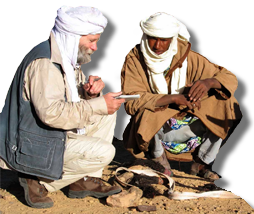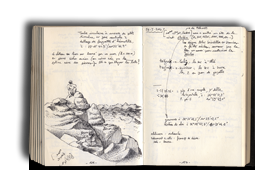Prehistoric rock paintings face destruction in the Sahara
James Wellard
(Times, February 24, 1968, p. 9)
Students and admirers of prehistoric art who wish to see some of the world's masterpieces of rock painting will be advised to visit two of the Saharan galleries soon, while many of the best examples are still visible. For from what I saw and learnt during a recent journey to the desert, there is not a great deal of time left before their destruction is fina.
The prehistoric sites in question are found in what was, until a few years ago, a remote region of the Sahara: the Tassili-n-Ajjer in southeast Algeria and the Acacus Mountains in southwest Libya. The former of these places is now accessible by ordinary means of communication; the latter still requires a well-organized expedition to reach. To those who are not familiar with the locale of Saharan rock art, it might be assumed that the two African sites are comparable with the European caves. But the conditions are not at all the same. The European paintings are, for the most part, underground, and they can easily be shut off to the public while the problems of deterioration are being studied, as in the case of Lascaux. Moreover, the French pictures are endangered by organic processes, and nobody can be personally blamed for the damage they have undergone. The Saharan frescoes, on the other hand, are in the open, on the sides of cliffs and rock shelters; and it is not a natural process that is impairing them, but human interference. Moreover, the problems of conservation are, by the same token, that much more complex. There are two main causes of the current damage. The first is the repeated swabbing down of the paintings, originally by members of scientific expeditions, now by tourists. The second is the deliberate prising from the rock face of the more remarkable pictures in order to smuggle them out as souvenirs.
There are, too, other forms of meddling which contribute to the impairment of the frescoes. Some of the more unusual, made famous by reproductions in books and magazines, have been noticeably touched up for purposes of colour photography. This was inevitable after the pictures in question had been repeatedly washed down and so lost their pristine freshness. Again, other sites, easily accessible to local vandals, have been spoilt by the addition of scrawls, signatures and, in one case which I saw, the crude drawing of a helicopter. This kind of desecration seems to have been perpetrated as if in mockery of the old artists who so painstakingly recorded their lives and times as they saw the world as long as 10,000 years ago.
The final factor which must surely lead to the eventual loss of these unique works of African art is their exposure to the elements, now that they have lost their protective covering of dust. In many of the shelters where the paintings are found, I observed that the rock face had been scoured and almost bleached by successive washings. This means that the dust can no longer adhere to the surface and the pictures themselves are exposed to the light, intense heat, and freezing cold of this formidable region of the Sahara.
The Tassili region has suffered most, since it has been intensively "researched " by French expeditions in the past and is now easily accessible to the casual traveller. Henri Lhote, doyen of the Tassili explorers, is quite frank in reporting why he resorted to this process of cleaning up the paintings during his 1956 expedition. He says in his book, The Search of the Tassili Frescoes, that until the dust was swabbed off some of the paintings were invisible to the naked eye. Unfortunately, successive travellers have continued the process of swabbing the paintings, some actually scrubbing them down with a rag dipped in dirty water; and there is not much doubt that many of the finer pictures have been almost obliterated as a result.
It is sometimes difficult to tell what is the work of the prehistoric artist and what of a modern copyist, though the original reds, for instance, have an intenser hue, due to the pigments having been nixed with animal blood. This retouching appears to have been used on the Monster of Sefar, the fantastic wall painting which Lhote calls " Great God with Suppliant Women." Similar treatment has evidently been given to another classic of the Tassili gallery, the exquisitely drawn vignettes of antelopes with crossed necks. The two central figures are still clear, but the remaining animals have almost disappeared, washed out without having been retouched.
Fortunately, instances of downright vandalism-hacking pictures from the rock face or disfiguring them with scrawls are rare as yet. But if one judges the mentality of some of the visitors by the unsightly mess they leave behind at their camps unburied tin cans, food cartons, and branches torn from living trees, these outrages will increase unless strict supervision is introduced by the Algerian authorities.
Why, it may be asked, are the full facts concerning the Saharan sites still not fully known ? The answer is that until a year or so ago they were terra incognita to the outside world. For that matter, the Acacus range is only found on the very latest maps of Libya. The Tassili-n-Ajjer, though charted, remained almost prohibited territory during the French occupation of Algeria. Travel in this region was exceedingly difficult, and the unauthorized observer had little chance of getting as far as even Djanet, the nearest oasis to the prehistoric site. To do so, involved crossing the Great Eastern Sand Sea and without the cooperation of the French military, the journey could hardly be undertaken at all due to the absence of good tracks south of Ouargla and to the problem of petrol supplies. In any event, the nationalist war closed the region altogether from 1954 to 1963. What are the chances of the ordinary traveller visiting these two prehistoric art galleries ? In the case of the Tassili-n-Ajjer, they are good. There is nothing to prevent the enthusiast from flying in comfort all the way down to Djanet, the oasis at the foot of the plateau. The flight is via Algeria from which a plane makes a twice- weekly trip to Djanet itself. For the energetic visitor, easy camel rides can be organized from Dianet to prehistoric sites near by. Some interesting paintings and engravings can be seen in this leisurely fashion. Those who wish to see the best examples, however, have to be prepared to make a long and arduous day's march up on to the plateau, and for this expedition the traveller needs to be in good physical condition to make the four long ascents over rockstrewn paths cut through the mountain passes. He will need guides and donkeys in order to see the most famous sites at Tamrit, Sefar, and Jabbaren. But these requirements have been organized by the Syndicat d'Initiative.
To get to the site in the Acacus Mountains is not so simple. The traveller must start from Tripoli, drive east past Leptis Magna to Homs, then turn south down the Fezzan Road by way of the Black Mountains to Sebha, capital of the Fezzan. So far, the journey can be made on a good tarmac road. At Sebha, however, the highway finishes, and the traveller must take a desert track to an oasis called Serdeles, 300 miles to the west. The difficulty is to obtain petrol for the 600 or more miles journey from Sebha, the last "civilized" outpost of this part of the Sahara. At Serdeles, where one begins the trip south into the Acacus proper, the Targi guide is essential otherwise one would not find the pass into the mountains at all. The traveller will quickly appreciate the necessity of a guide once he is inside the range, for the terrain consists of a series of deep valleys winding in every direction between the cliffs. Even the most experienced explorer could get lost in this maze. Three of us who were returning to our camp from an expedition to a prehistoric site five miles away all plotted a different opening in the cliffs as our route back. We were all wrong. Without a guide we would have been hopelessly lost.
The problem remains as to how these galleries of prehistoric art are to be policed and protected. Obviously both regions are too vast and too exposed to be continually supervised, and the most that the authorities can do at present is to instruct the guides to dis- suade visitors from washing down the frescoes preparatory to photographing them. But it is obvious that the frescoes need still greater protection if they are to be saved from inconsiderate tourists and especially from camera enthusiasts. The washing down and touching up of many of the most beautiful examples have gone far enough, in some cases, too far; and the best that can be hoped for where this damage has been done is restoration by specialists in rock art. Yet what can be done to preserve those examples which are still visible presents a problem which, at the moment, seems insoluble. For there are thousands of rock paintings throughout the Sahara and throughout the rest of Africa, for that matter, so that the expense of treating them by some chemical process, for instance, would be astronomica. One is forced, therefore, to conclude that apart from leaving them to be covered by dust again, there is not a practicable way of conserving then. But every traveller who has the privilege of seeing them before their eventual destruction should at least feel an obligation to respect these unique records from the dawn of history.





